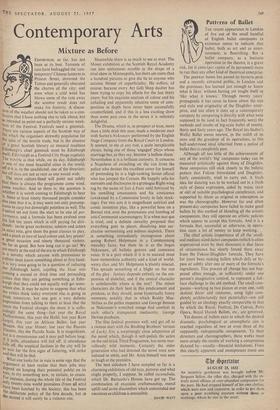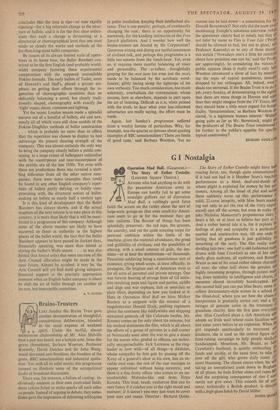Patterns of Ballet
THE recent appearance in London of five out of the small handful of English ballet companies in existence seems to indicate that ballet, both as art and as enter- tainment, is flourishing. But a ballet company, as a business operation in the theatre, is a grave risk, for it costs (per capita of its personnel) more to run than any other kind of theatrical enterprise.
The postwar boom has passed its hysteria-peak and a recently attracted public, in London and the provinces, has learned just enough to 'know what it likes' without having yet taught itself to 'like what it knows.' Through twenty years' propaganda it has come to know about the size and style and originality of the Diaghilev enter- prise, and too often it sizes up a contemporary company by comparing it directly with what were supposed to be (and in fact frequently were) the methods and results of big-scale ballet of twenty, thirty and forty years ago. The Royal (ex-Sadler's Wells) Ballet seems nearest, in the width of its aims and the grandeur of its operations, to this half-understood ideal inherited from a period of ballet that is completely past.
Although all too little of the achievements of any of the world's 'big' companies today can be measured artistically against those of Diaghilev, these companies still stick closely tothe balletic pattern that Fokine formulated and Diaghilev, fairly consistently, tried to carry out. A fresh idea for dancing was to be worked out in a fresh style of dance expression, aided by music (new or old) of suitable psychological complexion, and supported by decor as original in conception as was the choreography. However far and often present-day companies have failed to make good ballets by this method of blending all the artistic components, they still operate on artistic policies which appear to accept this formula. And it is a formula that, successful or otherwise, in opera- • tion costs a lot of money to keep working.
The chief artistic importance of all the small- and medium-sized dance companies (which is often unperceived even by their directors) is that force of circumstance has slowly forced them away from the Fokine-Diaghilev formula. They have for years been making ballets which defy or by- pass or subtly alter one or more of the formula's ingredients. This process of change has not hap- pened often enough, or sufficiently under one person's imaginative control, to represent a full- face challenge to the old method. The small com- panies—working to two pianos or even one, with skeletal decor and costumes, using light com- pletely architecturally (not pictorially)—are still guided by an ideology exactly comparable to that by which the Royal, Festival, De Cuevas, Paris Opera, Royal Danish Ballets, etc., are governed.
Yet dozens of ballets exist in which the desired dramatic, psychological or atmospheric aim is reached regardless of two or even three of the supposedly indispensable components. To their directors and choreographers, these works must seem simply the results of working a compromise dictated by—usually—financial limitations. From this clearly apparent and omnipresent trend one concludes that the time is ripe—or now rapidly ripening—for a big reformist change in the struc- ture of ballets; and it is for the first clear indica- tions that such a change is fermenting at a directorial or choreographical level that one must study so closely the works and methods of the les-than-king-sized ballet companies. By reason of its always limited scale of opera- tions in its home base, the Ballet Rambert con- trived to be the first English (and probably world- wide) company fostering these experimental compromises with the supposed unassailable Fokine formula. The early ballets of Tudor, some of Howard's and Staff's, placed a greater em- phasis on getting their effects through the in- amities of choreographic invention than on delicately balancing a novel, but clearly tradi- tionally shaped, choreography with exactly the 'right' music, decor, costumes and lighting. Yet the recent London season made a splendid success out of a handful of ballets, old and new, nearly all of which were still close models of the Fokine-Diaghilev methods of ballet construction . . which is probably no more than to affirm that the repertoire was chosen to display to best advantage the present dancing strength of the company. This was almost certainly the only way to bring the company clearly before a public con- sisting to a large extent of balletgoers unfamiliar with the masterpieces and near-masterpieces of the prolific era of the late 1930s. Yet even with these ten productions there was revealed a start- ling difference from all the other native com- panies; there were more examples than could be found in any other English company's reper- toire of ballets partly defying, or boldly com- promising with, the structural notion of ballet- making set before us nearly half a century ago. It is this kind of development that the Ballet Rambert has always shown, and if the actual eruption of the next reform is to take place in this country, it is more than likely that it will be mani- fested in a programme of this company. Although none of the above reasons are likely to have Occurred to those in authority in the highest places of the ballet world, the fact that the Ballet Rambert appears to have passed its darkest days, financially speaking, was more than hinted at during the Sadler's Wells season . . . as was also hinted (but hinted only) that some increase of the Arts Council allocation might be made in the near future. Almost by accident, it may be, the Arts Council will yet find itself giving adequate financial support at the precisely appropriate moment when an English ballet company is about to shift the art of ballet through yet another of its rare, but inescapable, mutations.
A. V. COTON































 Previous page
Previous page